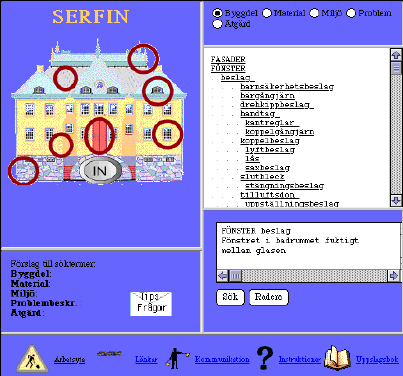
|
|
[From CIB Proceedings W78 Workshop, Cairns 9 - 11 July 1997, 'Information Technology Support for
Construction Process Re-Engineering, IT-CPR-97'.]
[top]
The paper describes how technical building maintenance in the future can be effectively communicated using Internet services. The research and development is done together with the potential end users of the system (9 large building operations and maintenance firms in Sweden). The national Swedish SERFIN , Maintenance Experience Communication on Internet, project is described together with the philosophy behind the system, underlying models, and enabling technologies. The system under development is a knowledge node on the Internet where users independent of room and time can search for quality marked information, place questions and get answers back. The system also captures knowledge within the area. The development work is supported by a working area and the in-house demonstrator development method. Both system and working area reside on the Internet. The latter are slowly transformed to an O&M area which supports all the processes for knowledge handling and content quality assurance. Experiences and lessons learned as well as underlying system functionality and structure are reported.
[top]
We are now facing the beginning of a gigantic change in how we reach, communicate, and augment knowledge through access of what we call the Dynamic Knowledge Net, DKN. (Christiansson, 1992). The DKN connects users with computer stored knowledge on a global scale. The users can access the DKN from more or less room independent points at any time. Internet and World Wide Web is the very first step in the development of the DKN.
We can envision a paramount scaling effect where many simultaneous users with different competencies and interests situated in optional places can access tools for enhanced personal communication. Digitally stored knowledge and communication tools are reached by the user through rich adapted multimedia interfaces independent of room and time. The single-user systems, local networks, and intranets are continuously connected to the DKN. World wide platform independent software is developed with high speed. Some of the underlying concepts such as knowledge nodes are described in (Christiansson, 1996) from last years CIB W78 conference in Bled, Slovenia. A Knowledge Node is a virtual artifact in the DKN which gives access to distributed computer stored knowledge and provides a communication surface between people. A knowledge node is usually referred to as a connecting point in the Dynamic Knowledge Net, DKN.
The paper describes experiences from development of a demonstrator for 'Communicating maintenance experience on the Internet'. It is shown how technical building maintenance in the future can be effectively communicated using Internet services. The research and development is done together with the potential end users (9 large building operations and maintenance firms in Sweden) of the system.
[top]
We can now begin to scale-up creative laboratory solutions to practical knowledge communication tools such as the here described SERFIN system. The SERFIN acronym stands for (translated into English) 'Maintenance Experience Communication on Internet'. We strive to design and implement a system that more effectively can capture and communicate technical building maintenance. A system which;
The system has been under design and development since spring 1996. It is now in the late phases of conceptual design using early data models for tests in real use. We believe that the enabling IT now let us scale up the particular solutions to more general ones and thus with high potential for spread and use. We can see or at least formulate how to handle security, unconstrained access in room and time, dynamic growth, adapted tools for use and maintenance, indexing of large information spaces, human interfaces with multimedial properties etc.
As new materials and products enter the market SERFIN also acts as a quality assurance feed-back mechanism. You get problems, findings and ideas up in the air;
[top]
You are engaged in renovating the ventilation system at your office site situated in the south of Sweden. A 'floppy' sound can be heard and at the same time you perceive an acid smell. You engage your communication unit and activate the flat luminous color screen. As your hands are oily you give spoken instructions to the unit. You are connected to a knowledge node with advices (tips) on technical building maintenance. You describe your problem in free text and get back relevance ordered advices. You get a satisfactory (sufficient) solution to the problem with analysis and even access to an interactive video film on how to make adjustments to the ventilation system. You now remember that your neighbor had a similar problem and digitally forwards the tip to him as a document with a reference to source (SERFIN) and sender (that is you).
It might happen that you could not find any usable information. Instead you fill in the question form available at the SERFIN knowledge node and attach two images you have taken showing suspect devices. You also consider to put it as a question on the conference area managed by the Swedish Building Research. But first you consult the so called Merkurius node at Lund University where you search for a possible explanation and hints to further contacts at the University. You also attach the problem description to the 'potential projects' note board of Merkurius.
The above described scenario is reality today in demonstrator mode within the three projects SERFIN (Maintenance Experience Communication on Internet), SWEBU (Swedish Building Research on the World Wide Web) financed by the Swedish Building Research Council, and the MERKURIUS project (Lund University company knowledge node) financed by the Swedish KK-foundation. See also (KBS-Media Lab, 1997).

|
|
The search is performed as a free text search in an automatically indexed local tip bank. The answers are given with relevance feed-back. If no adequate answers are given a question my be posed supplied with clarifying images. It is also possible to send in own tips and experiences. Seven big maintenance companies participate in the project Vasakronan AB, Statens Fastighetsverk, Akademiska hus i Stockholm AB, Hantverks- och industribyggen i Stockholm AB, Postfastigheter, Familjebostäder and Skandia Fastighet.
In the first system version there was a wish to make a graphical point and click area available to get proposals for search terms (see 'Förslag till söktermer' in the lower left corner of figure 1). After trials and evaluations in the design/demonstrator team it is now preferred to hide that area away and just call it up as a support palette when needed.
[top]
The traditional physical information/knowledge containers as books, films, images, papers, etc. are at present in many cases also (or even only) stored in digital form in what we call logical ('virtual') knowledge containers. This latter containers have properties that from now on will completely change our view on how knowledge are structured and represented and interactively presented.
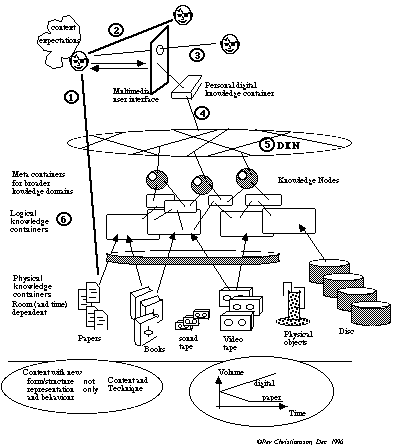
|
|
Now we face a monumental change both in communication support and the way we store and access digital information. We are used to put en equal sign between physical information container and the logical information wrapping. A book is a book today for most people and not something created on the fly with book properties but only limited life time (a book on how to put up flowery wall paper for example). The physical containers will still exist in the form of databases which for information highway bandwidth reason and security will be duplicated around the world. Many (meta) logic containers will not have to contain more than meta information and selection mechanisms to underlying logical containers like the view metaphor when you perform a SQL query on a relational database.
The underlying knowledge will on its lowest levels be represented in many ways - relational databases, objects, calculation programs, simulations, if-then rules, predicate logic etc. The actual wrapping procedures has just started to develop and will put focus on
[top]
The demonstrator method enables us to postpone the implementation of some enabling technologies until they are available outside the research community and more orchestrated for practical use, see figure 3. We strive to make system solutions as platform independent as possible. This leads today to use of World Wide Web based client-server solutions.
Besides the development of the original WWW concept (Berners-Lee T, 1989/90) we now see the development of a global object-oriented 'operating' system where among other tools the Java language plays an important role, (Blundon, 1996).
We use the following soft- and hardware for he SERFIN system;
[top]
The underlying models describe the actual applications, users, IT-tools and the surrounding contexts. The context is today reflected by the search words and possible search sentence. The creative design process follows the layout of figure 3, where it is indicated that the instantiation process progresses as we follow the design loop. Continuos evaluation and documentation is included in the demonstrator method.

|
|

|
|
The underlying user models supports
[top]
We need highly reliable IT-tools to be able to sell, buy and exchange information in the DKN. As stated in (Christiansson, 1996) we can distinguish three basic digital knowledge container domains - the personal, project and global. Information and knowledge flows from persons (with limited life length) to personal digital containers to projects (which also can be companies) towards the global level and free access added only search, transportation and presentation costs. The global containers we call libraries and some times museums. Of course many persons and 'projects' will donate (to whom, the libraries?) their digital information/knowledge containers and make them available for future search and use.
The IT-tools will in different contexts support;
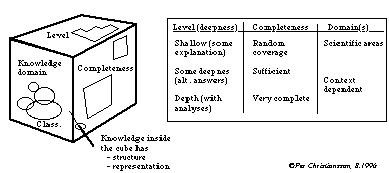
|
|
We spend some energy (pay for) access to information and knowledge. What will set the price on digital knowledge and its quality? (See also figure 5).
The knowledge market will change. Low quality information and competence will not sell as easy as today due to higher exposure and market feed-back. The quality assurance process will be more ruthless through high exposure of opinions on products and services advertised and available on the Internet.
The trade activities will change due to the use of Internet and software agents. We can expect that some activities will be (and already are to some extent) formalized and performed by agents. For example;
[top]
After a search has been performed as shown in figure 1 SERFIN delivers a list of advices (tips) with summaries and measures of relevance. Figure 6 shows an example of one advice. As can be seen in the figure the advice is given under headings
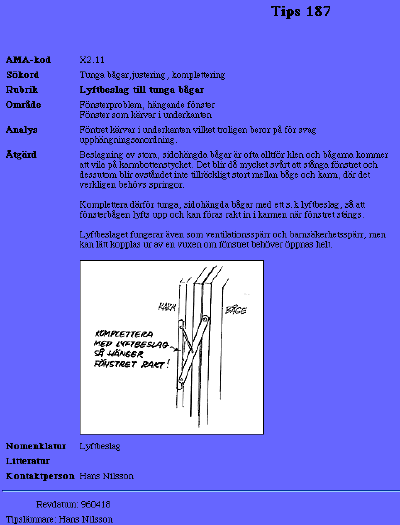
|
|
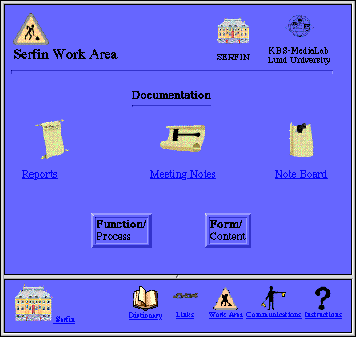
|
|

|
|
[top]
The paper describes how technical building maintenance in the future can be effectively communicated using Internet services. A scenario is presented on how an IT-supported maintenance environment may be designed and used. The national Swedish SERFIN , Maintenance Experience Communication on Internet, project is described together with the philosophy behind the system, underlying models, and enabling technologies. The system under development is a knowledge node on the Internet where users independent of room and time can search for quality marked information, place questions and get answers back. The system also captures knowledge within the area.
The development work is supported by a working area and an in-house demonstrator development method. Both system and working area reside on the Internet. The latter area are slowly transformed to an O&M area which supports all the processes for knowledge handling and content quality assurance. Experiences and lessons learned as well as underlying system functionality and form are reported. The research and development is done together with the potential end users of the system (9 large building operations and maintenance firms in Sweden).
[top]